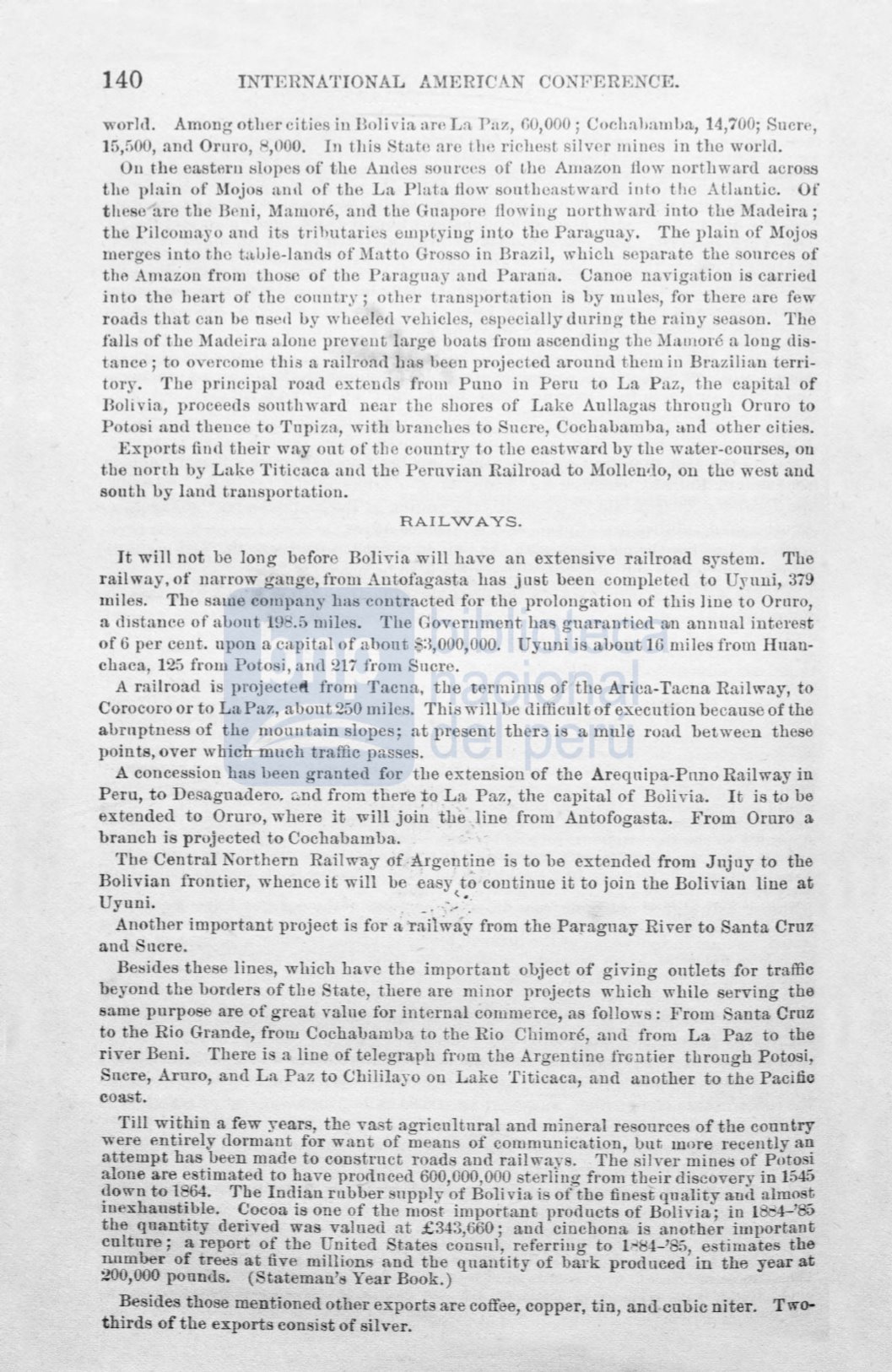

140
INTERNATIONAL .AMERICAN CO.._TPEREr"'CE.
worlt1. Amoug other cities in Bol ivia nrP La Pa:r,, ()0,000; Coclln.lmmLa, 14,700; Suen',
1!>,500, ::md Oruro,
,000.
In this, tate are
the
rirhe~;t
silvrr mines in the world.
Ou the ea tern slopcs of the Andes sonrces of
the
Amazon
Jiow
northward across
t11e plain of .Mojo · anll of the La Plata iiow soutbcastward into the Atla.utic. Of
th
o are tbe Brni, Maruoró, and tb.e Guaporo flowiug uorthward iuto the Madeira;
the Pilcomayo and it tributario: emptyi ng into the Paraguay. The plain of Mojos
mergo · into thc taule-lanfli:! of Matto Gros o in Brazil, which separate the onrces of
the Amazon from those of the Paraguay a nd Parana. Canoe navigatiou is carried
jnto the beart of the conntry; other transportation is by mules, for there aro few
roads tbat can be nsecl by wLcelecl vehicles, especially dnriug the rainy season . The
fall of tbe Madeira alone prevent ln.rge boaLs from aseending the Ma1noró a long dis–
tance; to o e rcome thia a railroad ha· been projected around thcm in Brazilian terri–
tory. Tbe principal road ext uds from Puuo in Peru to La Paz, the capital of
Bolivia, proceeds sontlnvard near thc shores of Lake Aullagas throngh Onno to
Poto
i
and theuce to Tupi zu, with branchcs to ncre, Cocbabamba, and other cities.
Exports find their way out of the conntry to thc eastward by the water-conrscs, on
the north by Lake Titicaca and the Peruvian Railroad to Mollen•lo, on tho west and
south by land tran portation.
RAILVVAYS.
Jt
will not be long before Bolivia will bave an extensiva rai1road system. The
railway,
of
narrow gaugo, from Antofagasta has just been completed to Uyuni,
379
miles. Tbe ame company has contracted for the prolougation of this liue to Oruro,
u.
chstauce of about
19
'.5 mile . Tbe Govemment has guara.ntied
UID
anuual interest
of 6 per cent. opon a capital of r1>bout
·:~, 000,000.
Uyuni is about 16 miles from Huan–
chuca,
125
from Potosi, and
217
from Sncre.
A
railroad i project et\ from Tacna, the terminns of the Arica-Tacna Railway, to
Corocoro orto LaPa?:, abont250 miles. Tbis will be difficnlt of execution becan eofthe
abrnptne
s
of the mountain slopes ; at present thera is a mnle roail between tbese
points, over wbiclr-mucb traffic passes.
A concessiou has been granted for the exten ion of the Areqnipa-Pnno Railway in
Peru, to Desaguadero. ::..ud from there toLa Pa?., the capital of Bolivia.
It
is to be
extended to Ornro, wbere it will
joi~
the line from Antofogasta. From Ornro a
branch is projected to Cochabaml>a.
Tue Central Northeru Railway of -Argentine is to be extended from Jnjuy to tbe
Bolivian frontier, whence it will be easy to continne it to join the Bolivian line at
Uyuni.
_.
. .-.:·,-
Another important project is for a'railwáy from tbe Paraguay River to Santa
Cruz
antl
ucre.
Beside these line , whicb huve the important object of giving ontlets for traffio
b yond tbe borrlu oftbe State, tl1ere are m inor projects which while serving the
sa.mepurpose are of great valne for internal commerce,
a
fo1lows:
E
rom
anta Cruz
to the Rio Grande, frow Cochabamba to the Río Chimoré, and froru La Paz to the
river Beni. There i a line of tele<Yraph from the Arg11ntine frGntier tlll'ongh Potosi,
Sncre, Aruro, and La Paz to Cbililayo on Lake Titicaca, and auother to the Pacifio
coast.
TiH within a few years, tbe va
t
a.gricultnral ancl mineral re onrces of the country
were entirely dormaut for want of means of commnnication, bu
t.
more recently
a~
attempt has been made to con truct road an l rail ways. The silver mine · of Poto
1
a1one are e timated to have proilnced 600,000,000 sterliug from tbeir discovery in
1545
~own
to 1 _64. Tbe ludian rubber npply of Bolivia
i
ofthe fine
t
quality ami
almo~
wexhau t1ble. Cocoa is one of the most important products of Bolivia; in 1
4-'85
tbe qu. ntity derived was valned at ;(343,660; and cincbona is anotber important
culture; a report of the United State consnl, referrü1g to 1""
-1- '
5, e timates the
nnmber of tree at five millioru and tbe quantity of bark produoed
iu
the year at
200,000 ponnds.
( tateman' Year Book.)
Be ide those mentioned other exports are coffee, copper, ti u, anu cubic niter. Two–
third of the exports con
i
t of silver.
















